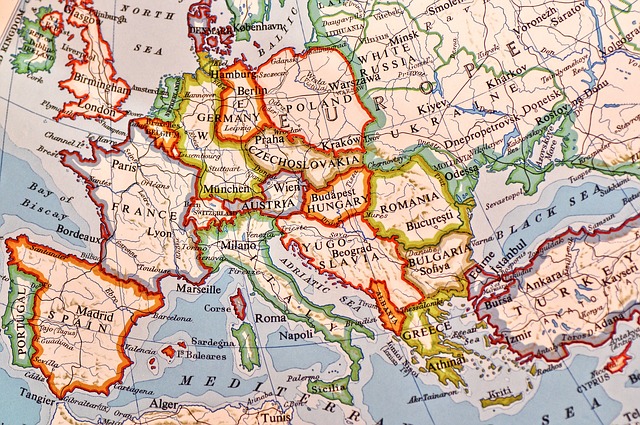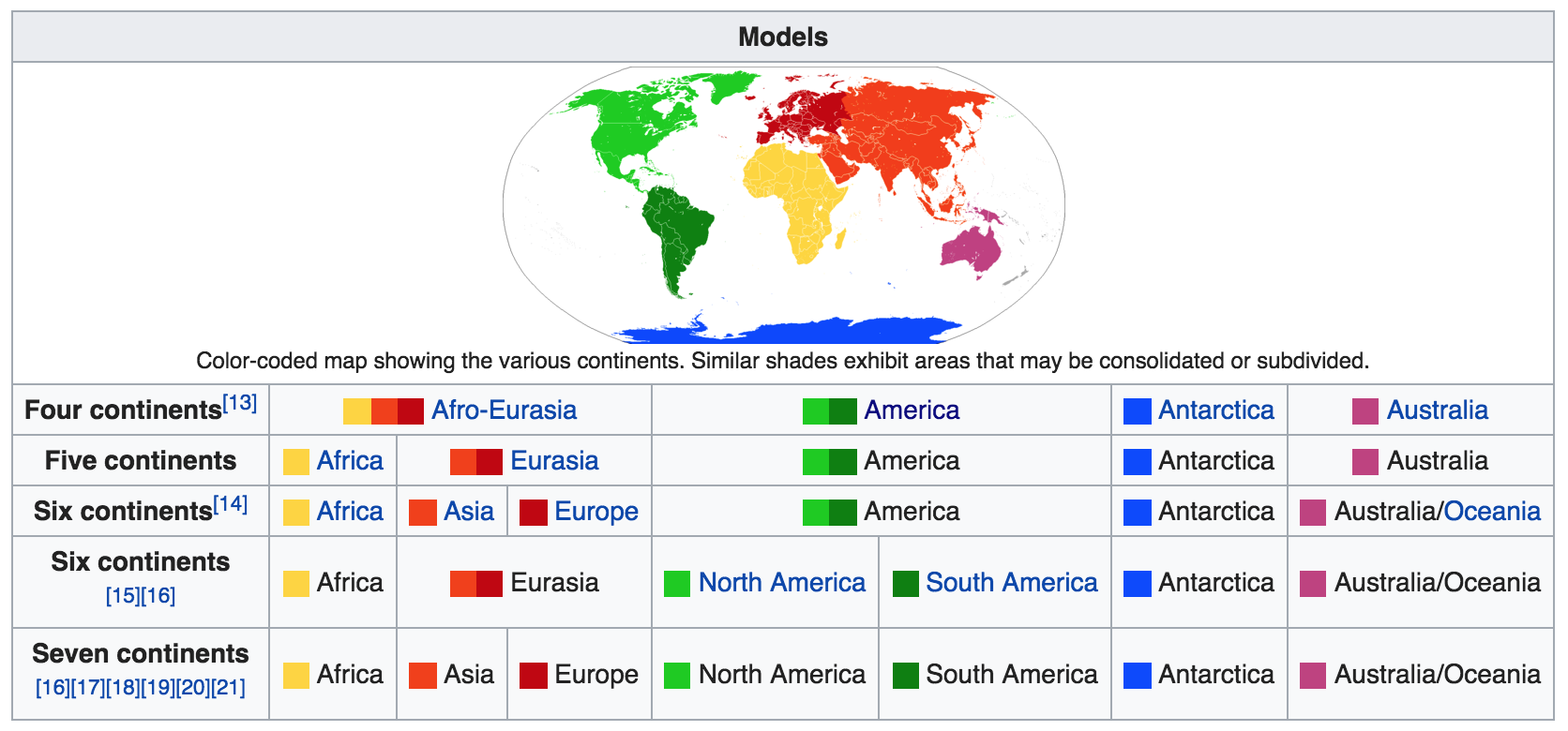Welcome to Europe Day.
Introduction.
Today you will be learning about some of the major countries in the continent of Europe and taking a journey across them.
You have been provided with a HUGE outline map of Europe and you have access to various maps of the continent including one here.
Session 1 – What is a continent?
A continent is one of several very large landmasses of the world. In most English speaking countries seven regions are commonly regarded as continents. In other parts of the world people may consider there to be only four, five or six continents. Ordered from largest in area to smallest, they are: Asia, Africa, North America, South America, Antarctica, Europe, and Australia. You can see the continents here.
Where is Europe?
Total population: 696 million.
Number of countries: 43.
Europe is a continent located entirely in the Northern Hemisphere. It is bordered by the Arctic Ocean to the north, the Atlantic Ocean to the west and the Mediterranean Sea to the south.
Since around 1850, Europe is most commonly considered to be separated from Asia. Turkey, Russia and Kazakhstan are transcontinental countries (countries located on more than one continent).
The countries and borders of Europe have changed many times over the centuries. For a long time almost all of modern day Europe was a part of the Roman Empire.
What about the European Union?
The European Union is not a continent. Everyone’s talking about brexit right? Well that’s a plan for The United Kingdom to leave the European Union. If and when it does it will still be a part of the continent of Europe because continents are based on….. geographical regions.
So what is The European Union?
The European Union (EU) is a political and economic union of 28 member states that are located primarily in Europe. It has an area of 4,475,757 km2 (1,728,099 sq mi) and an estimated population of over 510 million. The members of the EU have agreed to act as one to ensure the free movement of people, goods, services and capital. In other words you can go and live, travel, learn and trade freely anywhere with the EU.
Session 2 – Western Europe
We are going to start our journey in Western Europe, beginning in France and travel by rail and ocean to The United Kingdom and then by ocean and road to Germany.
France
France is the largest country within Western Europe.

Fun Facts about France:
Population: 60,742,000 people
Capital City: Paris, 9,854,000 people
Language: French
Currency: Euro
Activity Time.
- Find Paris, France on your map and mark it with a blue and red spot.
- Draw a train track from Paris to the border closest to The United Kingdom.
- Fill in your fast facts (don’t forget to add one of your own.)
United Kingdom
The United Kingdom is considered part of Europe, although it is separated from the European continent by both the English Channel and the North Sea. It is informally called ‘Britain’ and includes England, Scotland, Wales and Northern Ireland.

Fun Facts about United Kingdom:
Population: 60,068,000 people
Capital City: London, 7,615,000 people
Language: English, Welsh, Scottish form of Gaelic
Currency: British Pound
Activity Time.
- Find London, UK on your map and mark it with a red cross.
- Draw a line with a tiny boat from the border of France to the border of The United Kingdom nearest to London. London can be reached by ocean.
- Fill in your fast facts.
Germany
Germany has had a very difficult history and has grown out of the disasters to become one of the strongest industrial and economic powers in Europe.

Fun Facts about Germany:
Population: 82,490,000 people
Capital City: Berlin, 3,327,000 people
Language: German
Currency: Euro
Activity Time.
- Find Berlin, Germany on your map and mark it with a yellow and black spot.
- Draw a line with a tiny boat from London to the border of Germany.
- Draw a dashed line with a tiny car from the border of Germany to Berlin.
- Fill in your fast facts.
Session 3 – Scandinavia
We are going to continue our journey by traveling to Scandinavia. We will travel to Sweden by road and boat and then across land to Norway by road.
Sweden
High standards and quality of life have given Sweden one of the highest life expectancies in Europe.

Fun Facts about Sweden:
Population: 10.2 million
Capital City: Stockholm
Language: Swedish
Currency: Krona
Activity Time.
- Find Stockholm, Sweden on your map and mark it with a yellow cross.
- Draw a dashed line with a tiny car from Berlin to the border of Germany.
- Draw a line with a tiny boat from the border of Germany to Stockholm, near the border of Sweden.
- Fill in your fast facts.
Norway
Norway is considered to be the home of the Vikings and they were a sea-faring culture.

Fun Facts about Norway:
Population: 4,620,000 people
Capital City: Oslo, 795,000 people
Language: Norwegian
Currency: Norwegian Krone
Activity Time.
- Find Oslo, Norway on your map and mark it with a blue cross.
- Draw a dashed line with a bus/coach from Stockholm to Oslo.
- Fill in your fast facts.
Session 4 – The Russian Federation (Russia)
Russia is the largest country in what is considered to be the Euro-Asiatic area. We are going to travel through the skies to get there.

Fun Facts about Russia:
Population: 142,470,272 people
Capital City: Moscow 11,621 million people
Currency: Ruble
Language: Russian
Activity Time.
- Find Moscow, Russia on your map and mark it with a red star.
- Draw a dashed line with a tiny car from Oslo to the border closest to the Norwegian Sea.
- Draw a line with a tiny airplane across the ocean to the Russian border.
- Draw a train track from the border to Moscow.
- Fill in your fast facts.
Session 5 – Eastern Europe
It’s been a long journey. We are making just one stop in Eastern Europe, to Ukraine.
Ukraine
Throughout its history Ukraine has been the center for battles by many cultures to take over the area. Access to the Black Sea made it a key territory for Russia.
Let’s watch to some modern Ukrainian music:
and some traditional music and dancing:

Fun Facts about Ukraine:
Population: 47,110,000 people
Capital City: Kiev, 2,618,000 people
Language: Ukrainian, Russian, Romanian, Polish, Hungarian
Currency: Hryvnia
Activity Time.
- Find Kiev, Ukraine on your map and mark it with a blue star.
- Draw a train track from Moscow to Kiev.
- Fill in your fast facts.
Session 6 – The Mediterranean
To complete our trip around Europe we are going to visit three Mediterranean countries, all in Southern Europe. There is going to be lots of sea and air travel because the Mediterranean Sea is a body of water all around that area.
Greece
Greece is located at the crossroads of Europe, Asia, and Africa. Greece has the longest coastline on the Mediterranean Basin and the 11th longest coastline in the world. It features a large number of islands, of which 227 are inhabited. One that is uninhabited is the ancient island of Delos.
Fun Facts about Greece: 
Population: 10,768,477
Capital City: Athens
Language: Greek
Currency: Euro
Activity Time.
- Find Athens, Greece on your map and mark it with a blue outlined cross.
- Draw a train track from Kiev to Piraeus, a port close to Athens.
- Fill in your fast facts.
Italy
Italy is known as the Italian Republic and is the furthest most tip in southern Europe, known for its ‘boot shape’.

Fun Facts about Italy:
Population:58,742,000 people
Capital City: Rome, 2,628,000 people
Language: Italian
Currency: Euro
Activity Time.
- Find Rome, Italy on your map and mark it with a green and red spot.
- Draw a line with a boat (a ferry!) from Piraeus to Rome.
- Fill in your fast facts.
Spain
Most of the main land areas of Spain are high plateaus with the northern areas covering mountain ranges which include the Pyrenees. Spain has had a history that has included being one of the most powerful nations in the world.

Fun Facts about Spain:
Population: 43,484,000 people
Capital City: Madrid, 5,145,000 people
Language: Castilian Spanish, Catalan, Galician, Basque
Currency: Euro
Activity Time.
- Find Madrid, Spain on your map and mark it with a red spot.
- Draw a line with an airplane from Rome to the border of Spain which is closest.
- Draw a dashed line with a tiny car to the city of Madrid.
- Fill in your fast facts.
Session 7 – Wrap up.
Activity Time.
- Fill in your Europe – Countries chart with as many countries as you now know (feel free to add in any cities or oceans that you know as well.)
- Take this quiz.
- Watch the last video and don’t forget to turn the sound up LOUD first.
Files

